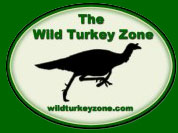|

Fall
Turkey Calling Techniques
By T.R. Michels, Trinity
Mountain Outdoors
When you call turkeys in the fall
it's helpful to understand the differences between
spring and fall calls. Since the birds most likely
to respond to calling in the fall are the young, you
should use the calls of the hen and her young. In
the spring the poults signal to the hen that they
are lost by using the three note Lost Whistle; a high
pitched peep, peep, peep. As the turkey poults grow
their voices change, and the Lost Whistle they used
in the spring becomes the Kee-Kee, which is
the juvenile version of the "Here I am. Where
are you?" or Lost Yelp, of the adult birds. This
call should probably be re-named the Kee-Kee-Kee.
Sonogram recordings of the Kee-Kee show that it usually
consists of three (not two) unevenly spaced .10-.15
second notes, performed in one second. The first note
is short and not as high pitched as the last two notes,
and the call generally rises in pitch.
The juveniles also use the Kee-Kee
Run in the fall. The Kee-Kee Run starts out like
the Kee-Kee, usually with two to four "kee"
notes, with five to seven yelps added. The entire
call is performed in about two seconds; kee-kee-kee,
yelp, yelp, yelp, yelp. When the birds use this call
they are saying, "I'm over here. Where Are You?"
Both the Kee-Kee and the Kee-Kee Run are used by the
juveniles as they try to get back together after they
have been scattered.
The Lost Yelp is the lost call of an adult
bird. It may have as many as six to twenty or more
evenly spaced notes, with three to four notes per
second. The call gets progressively louder with each
note and is often quite raspy. This raspiness occurs
because the bird's voice breaks as it tries to make
the call as loud as possible. It may be used by jakes,
toms and hens to get back together.
The Assembly Yelp is used by the hen to let
the young know where she is, so they can get back
together. This call usually consists of six to ten
or more evenly spaced yelps, with each note from .10
to .20 seconds in length. Because juveniles know their
mother's voice, which you probably can't duplicate,
this call is often ineffective in the fall.
Turkeys often use a Plain Cluck as they respond
to another bird's calling. They also use the Plain
Cluck as they approach another bird while trying to
locate it by sight. The Plain Cluck is a short call,
usually consisting of one to three notes per second,
with each note about .04 second in length. Remember,
when the bird is performing this call it is trying
to attract the attention of the other bird, it is
loud.
The Fast Cutt or Cutting is a series of fast
clucks, but louder and more insistent than the Plain
Cluck. The Fast Cutt usually consists of four to ten
notes, with from three to six notes per second, and
each note being .04 seconds in length (as short as
you can blow). It starts out with one short note per
second, and increases in loudness and speed to five
to six notes per second. This call is performed by
a bird that is telling another that if they are going
to get together, the other bird has to do the walking.
Roughly translated, "I'm not going there, you
come here."
Because many of the birds you call
to in the fall are young, they respond best to the
three versions of the lost call; the Kee-Kee, the
Kee-Kee Run and the Lost Yelp, especially after they
have been scattered. Obviously the soft putts, purrs
and whines of a feeding flock can arouse the interest
of the birds during the fall. Much of this interest
is caused by curiosity about who the other birds are,
and why they are there.
You can also use the sounds of a fight to attract
turkeys (Fighting Purr, wing flapping). Anytime
there is a fight almost every bird within hearing
will come running, because there may be a shift in
social structure of the flock, and the birds will
want to take advantage of a chance to enhance their
own social status if a dominant bird is beaten in
a fight.
Along with good calling you need a good stand site,
which offers a clear field of view and shooting lanes.
If you can see the birds you have a chance of seeing
how they react to your calls, so you can make adjustments
to calls that work. The use of decoys in any situation
is a definite asset. If the birds not only hear, but
see another bird, it helps instill confidence and
enhances the curiosity factor.
If you are interested in more turkey hunting tips, or
more turkey biology and behavior, click on Trinity Mountain
Outdoor News and T.R.'s Hunting Tips at www.TRMichels.com.
If you have questions about turkeys and turkey hunting
log on to the T.R.'s Tips message board. To find out
when the rut starts, peaks and ends in your area click
on Whitetail Rut Dates Chart.
This article is an excerpt from the Turkey Addict's
Manual ($14.95 + $5.00 S&H), by T.R. Michels,
available in the Trinity Mountain Outdoor Products
catalog.
T.R. Michels is a nationally recognized game researcher/wildlife
behaviorist, outdoor writer and speaker. He is the
author of the Whitetail, Elk, Duck & Goose, and
Turkey Addict's Manuals. His latest products are Hunting
the Whitetail Rut Phases, the Complete Whitetail Addict's
Manual, the 2005 Revised Edition of the Elk Addict's
Manual; and the 2005 Revised Edition of the Duck &
Goose Addict's Manual. For a catalog of books and
other hunting products contact: T.R. Michels, Trinity
Mountain Outdoors, E-mail: TRMichels@yahoo.com , Web
Site: www.TRMichels.com
|

